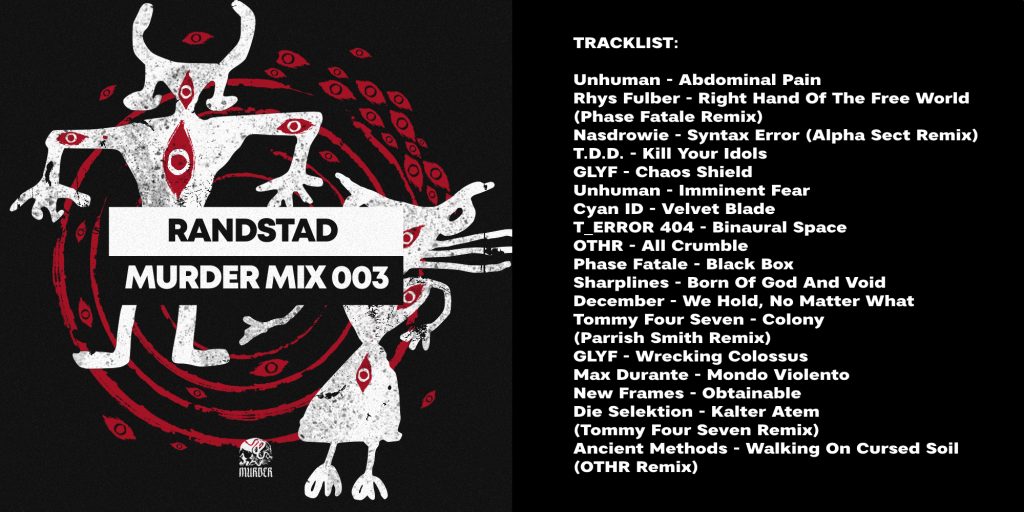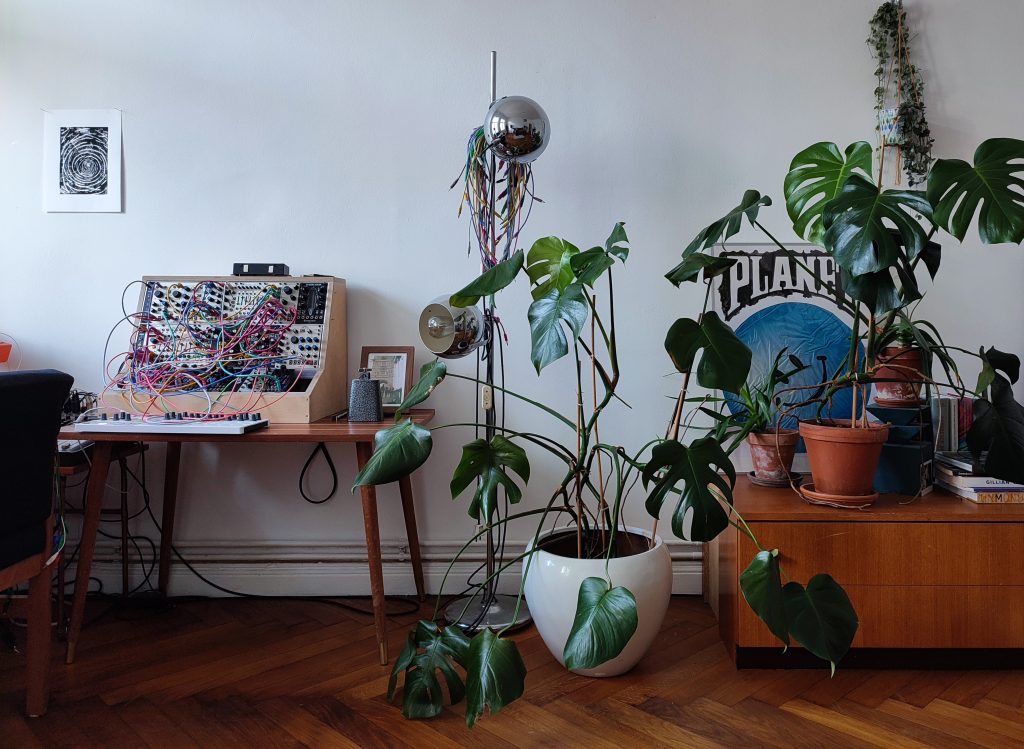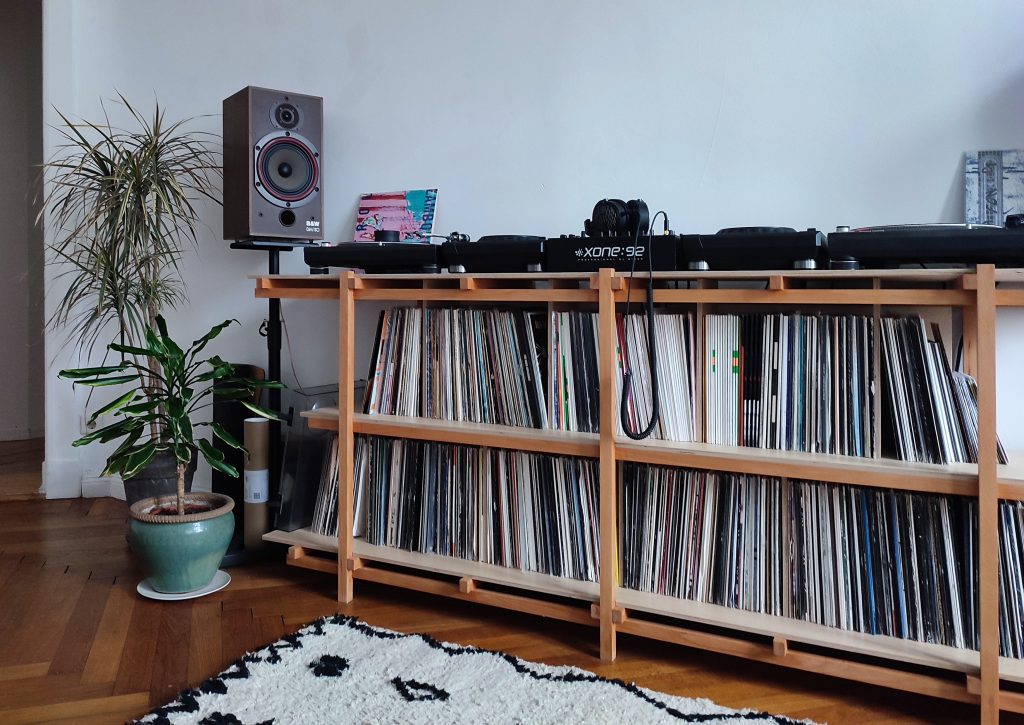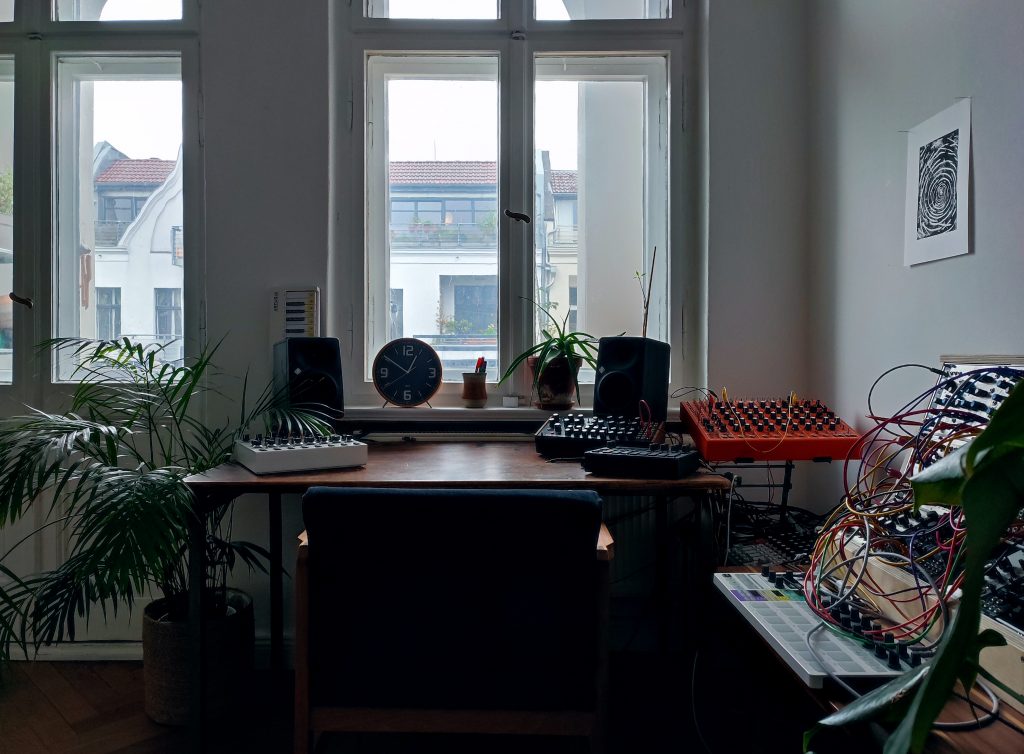
Podcast + Interview with Randstad
Randstad is the music moniker of dutch artist Thomas van Linge, co-founder of record labels BAKK and Rubber. Despite being a prolific DJ and producer with releases on record labels like Pinkman and Veyl, Thomas is multimedia artist and author of many interesting art pieces. To celebrate his recent contribution for Murder Mix series we talk with Randstad about his beginnings, inspiration behind his work and what is it like to be a contemporary artist and make art beside DJ-ing and producing music.
Hello Thomas, before getting to the essence of our interview, tell us a bit about yourself, what is your background and what made you become an artist?
Hi, thanks for having me at Murder Tbilisi, it’s a pleasure to be here, big fan of the label.
I became interested in music and club culture more seriously through art. In 2006 I moved to The Hague to attend The Royal Academy of Art and met loads of new people affiliated with the art scene and squatting scene in The Hague. I had no real clue about electronic music but did always have a fascination for different kinds of counter-culture and subversive discourse. It didn’t take long for me and my friends to start hosting parties in and around the art school. It became a fun and weird mix of the local squatting scene, the art and fashion scene and the local DJ scene. This is how we got in touch with The Hague and Rotterdam based artists like Legowelt, Serge Clone, David Vunk and Marsman etc. and then we started booking them for our parties.
Honestly, at first I was mainly into it for the parties and the people. But as time went on my ideas and notions surrounding clubculture became more defined. That’s how I got to start DJ’ing, by playing opening and eventually closing sets at our own parties in The Hague and Rotterdam. Back then this kind of acid west coast sound was pretty big in the Netherlands. People like DJ TLR from Creme Organization and Unit Moebius were playing a rawer sound and that got my attention big time. At the time Guy Tavares was still throwing his Panzerkreuz / Bunker Record parties in his dungeons underneath an old squatted school where he lived and worked. You’d pay a tenner to get in and could get a complementary hit of acid at the door if you wanted haha. Wild times. In the years after we hosted many different events, did live radio with an audience on Intergalactic FM with guests like Mick Wills and Mark Knekelhuis.
In the meantime I’d been toying around with making some tracks and playing them in clubs. It was just fun and never intended as something really serious. It was only later when Marsman from Pinkman records heard me play some stuff and he said I should keep going and send him some tracks for the label that I became aware that potentially releasing something was actually a possibility. That’s how I started working towards my first solo release on Pinkman.
What is your creative working process like? Could you tell us about your ultimate studio setup?
Because of my visual art practice I was used to this process of experimentation, failure and spontaneity. I realized quickly I wasn’t getting this experience inside a DAW. I messed around with some cheap synths but those also didn’t trigger my curiosity. That got me involved with modular synthesis. I’d always wanted to ‘understand’ how sound worked on a more technical level, and getting started with modular seemed like the perfect learning curve for me. That’s how my current studio setup started, out of that curiosity. I didn’t really get to making music until maybe a year later. Just playing around was my main goal at first. I read a lot online about how modular is a steep first synth choice and not very beginner friendly, but for me it was perfect. It allows for so many unforeseen and amazing things to happen during the process of soundmaking.
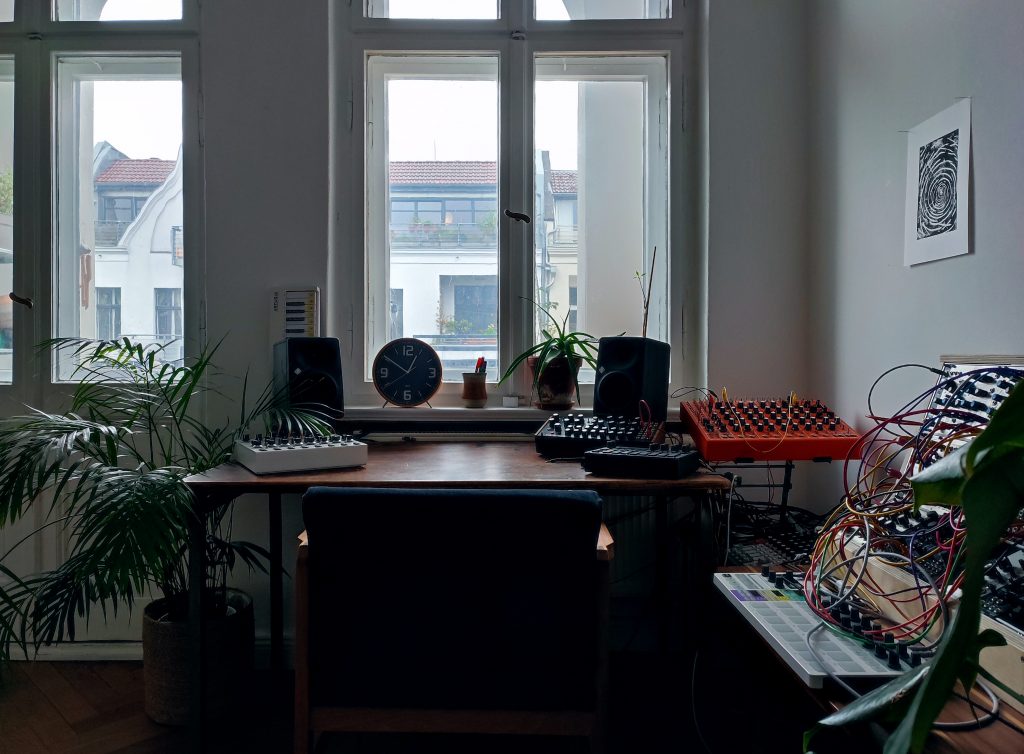
At the moment, I have four synths and one sampler. The modular, the SOMA Lyra-8, SOMA Pulsar-23, the Moog DFAM and an Elektron Digitakt. All of these elements are very diverse and allow for a big range of different sounds. It’s a collection that took shape over a few years where different things were tried and tested and replaced by others. The modular obviously is a collection of different synths and other functions but I usually operate it as a standalone instrument. In my earlier tracks I made almost everything exclusively on the modular but now I’m very happy to have some other additions to the family. I got most of my things second-hand and by trading gear with other musicians. My favorite piece of hardware besides the modular is definitely the Lyra-8. It just sings so beautifully and so differently every time I use it. It finds a place in all of my tracks, without exception. Soma is an amazing company run by Vlad Kreimer who is a very interesting performance artist from Russia. Another recent addition I absolutely love are some modules from Cosmotronic, a small synthesizer company from The Hague run by an old friend and fellow visual artist Matthijs Munnik. Their complex oscillator and upcoming distortion module are stunning.

Currently, I have my studio at home, in the corner of my living room. Ideally I’d like to get a separate room and make my own acoustic treatment. I’ve been researching a lot about room acoustics and if I ever get a chance to build what I have in mind that would be amazing. Regarding the ultimate setup question, that’s a thought I usually try to avoid. This kind of gear-fomo is one of my pitfalls. ‘If I had better speakers and better treatment my sound could become more defined”, “If I had this 8000,- wavetable synth I could make wilder soundscapes” etc. I end up researching all these things I can’t afford or don’t even have space for, instead of just turning on my gear and tuning in. I’m already overwhelmed sometimes with the setup I currently have.
This year you released a solo EP “These Serpents” on Veyl, tell us more about the release itself, how was the work process and what was the inspiration behind your work?
These Serpents is a collection of tracks made while I was moving around a lot between London and Berlin. I think being in different places explains some of the different energies going on on the EP. I made most of the record with a small modular travelcase, the Moog DFAM and the Elektron Digitakt Sampler, which were all easy to take with me on the road.
At the time I was really busy with my visual art, doing lots of exhibitions and working in my artstudio 24/7. Music really became a way to vent some of that work energy / exhaustion. My artistic process with my artworks is quite slow and demanding usually. It takes a lot of planning and working with fabricators, putting together a budget and finding the right materials at the right time. Music however, for me, is way more direct. DJing also does this for me. I twist a knob and something happens, something or someone responds immediately. This can be such a relief versus the tenuous process that is art-making.
So in hindsight, I think these notions of being in different places, being busy and even somewhat burnt-out at times, or just feeling this release of energy in the music are things I can hear back in the tracks. The title These Serpents popped up into my head and somehow I knew this was the title. Because these different tracks with different tempos and energies felt like snakes hiding in the grass of this other world that was my art practice at the time.
You are co-founder of BAKK and RUBBER record labels, how did these projects came to be and is there anything you learned as a label owner?
Like I mentioned earlier my friends and I used to host a lot of parties in and around art school when we were younger. After a certain number of years the whole process of running nights and dealing with different clubs and crowds had reached a point of saturation. We came to that point where we were facing a decision. Do we go big, or do we go home? Do we really want to make promoting parties a thing, or do we want to start focussing on the music? Because we all came from art, fashion and design backgrounds it felt like quite a logical thing to want to manifest those parties and memories into physical objects. That’s how the record label started. We just wanted to hold the music we heard at our parties in our hands. Have something to show for it.

I always really appreciated having seen both the artist and the label side of our music scene. Both labels and artists can have some kind of unapproachable mythical status in the eyes of others but in the end it’s all just people doing what they love. If you recognise this and appreciate this everything seems to become more tangible. I think it made me a lot more confident to just write labels for my own music and write other artists with proposals for our own labels.
Another thing it really showed me is how important community can be, especially if you are trying to take an active role in this. I’ve gotten in touch with so many different amazing people through the label, people I hold in high regard. I’ve also curated our experimental RUBBERTIJD podcast for our Rubber Label for the past 2.5 years which created great opportunities to work together with some of the finest DJ’s and selectors. By trying to be active in all these different communities you slowly build out networks that you can work with. I’m truly grateful for collaborating with so many different kinds of artists.
What is it like to be a contemporary artist and make art beside producing music?
Music started as a way to get a break from art. Art was always a slow and steady process for me and I used music to counter-act this feeling. Turn a knob, something happens etc. It was exhilarating and a nice change from the long hours I would spend in my art studio. However I can’t really do something half-assed so slowly music became a more dominant expressive tool for me.
Most of my artworks are inspired by our nightlife community and the people, imagery, objects we find on the perimeters of our club-discourse. So in a way, even when I’m not making music, I’m thinking about music. At least about the histories and its cultural and visual heritage. I’m intrigued by the role of (electronic) music in counterculture and subversive thought. I guess I’m wondering about what the role is of the spaces we dance in, the sounds we make, the images we produce and the crowds we move with and how does it relate to different cultural and political ideologies.
Still, so far most of my music work has been in the realm of music and most of my art work has been in the within the paradigm of contemporary art. They inform each other but also exist autonomously in my practice.
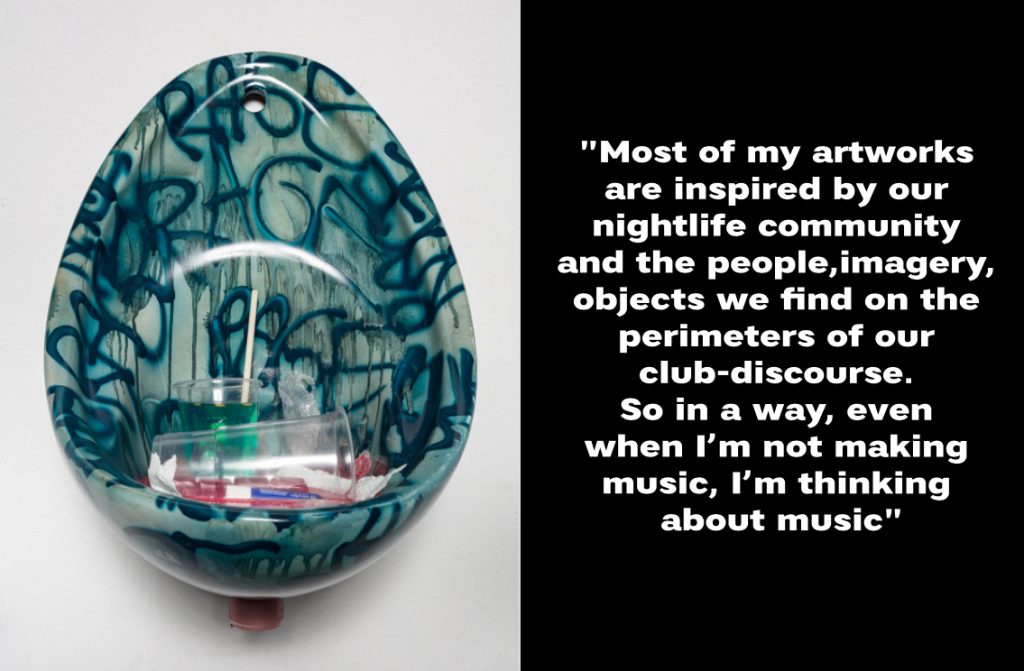
How do you manage to maintain your peace and mindfulness during the COVID-19 pandemic? What was most challenging for you due to the virus?
The pandemic has been tough for me. It took a big toll on my mental health and productivity. Sure, in the beginning I was loving the amount of spare time I had and I tried making a lot of music. But quickly I realised that so much of my creative output is informed by real life experience. The longer everything stayed closed and the longer I was isolated from different communities the less I could be bothered to create something.
For the first months of lockdown I was still living in London. I had just finished an 8th month artist-in-residence work period between Amsterdam and Berlin and arrived back in London pretty burnt-out. After working 7 days a week for 8 months straight I welcomed the rest and isolation during the first months of lockdown. Anyway, without dwelling on the subject too much, I’m mostly happy that we are slowly entering a new phase. We have a lot to think about and to work on as a people.
I tried loads of things to keep my mind and body in balance. From holotropic breathwork to psychedelics and from yoga to cold exposure. I’ve been slacking a bit lately with it all though and need to get back in the rhythm. I’ve just been chasing other rhythms lately and been out dancing and having a good time. Also very important for mind body balance haha.
I definitely appreciate clubs and their respective heterotopias even more than prior to the pandemic. I’ve missed not only their escapist, social-political and cultural qualities, but also the notion of moving in space as a collective body all swept up by the same rhythms. There’s an abstract force there which has powerful spiritual elements. A kind of stranger-intimacy.
What about the future for you personally, as both musician and as a contemporary artist?
I’m currently working on a new solo release and looking for a new art studio in Berlin to work on the next big body of work. To be honest, I’m still trying to shake off some of that ‘covid-slumber’ and really get back into peak productivity like before the pandemic, but this time with a bit more focus on a mental health and general well being.
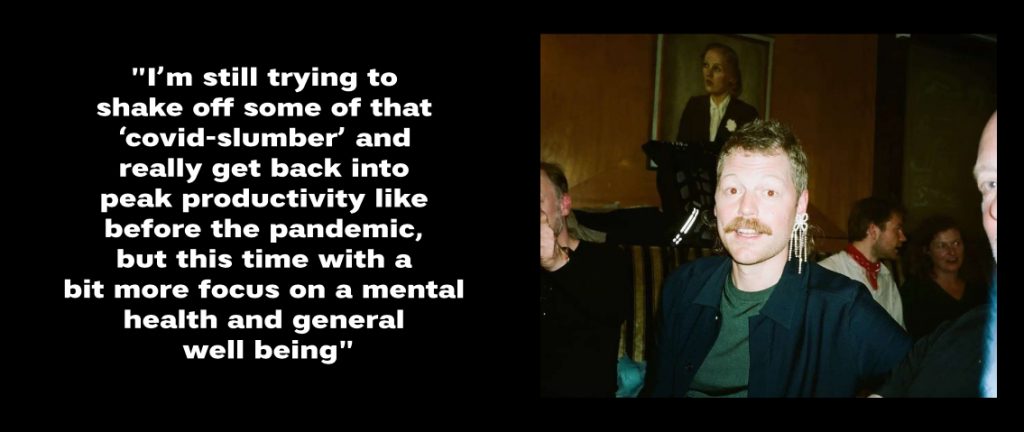
Mostly I’m really excited to get back to work and play gigs again. Also I’ll be continuing my bi-monthly residency at HÖR in Berlin and I’m signing with a London based booking agency in the near future. With regards to the labels, we’re currently focussing on getting some more of the Plafond series going on BAKK. These are the ambience / experimental long duration releases we’ve done with artists like Zoe Mcpherson, Bear Bones Lay Low and Cucina Povera. We are talking to some amazing composers about future records.
Meanwhile Rubber is slowly but steadily moving. We’ve got a few podcasts and a few releases coming out but nothing I’d want to spoil in advance. I can tell you that the next upcoming one is a banger though and building on the musical connection and history between Chicago and The Hague.
Could you tell us a little about the podcast you recorded for us? What was the idea behind the mix and could you mention a few favorites from the tracklist ?
I recorded it at home the morning after playing a gig at Suicide Club here in Berlin. I think it’s a translation of finally feeling some club energy again after this pandemic. I already noticed during the winter that the longer the clubs stayed closed, the more my need for rawer, darker and faster sounds grew. I also happily embrace the fact that everyone is playing faster again, which I really like. When I started DJing I was always buying up techno records second-hand from labels like Sonic Groove, Blueprint, Synewave, Djax etc. and they were always fast. So this uptempo pace feels very familiar to me and is like circling back to how I started.
The selection kind of happened as I recorded the mix, I didn’t really set it up specifically. Its tracks I also took with me to the club the night before. My sets usually sound quite busy because I like playing tracks with a song-like structure and a full sound spectrum, and I enjoy long mixes. Those two aren’t always an easy match, but I like the sonic fight that happens between frequencies when there are too many of them at once.
Although this mix is pretty genre consistent I don’t really think in genres too much generally. One of my only criteria is that the sound-structure has to be sonically challenging, whatever that means. It has to trigger some kind of fight or flight response in me.
Instead of mentioning favourites I’d rather just share the tracklist and let people look up the artists and find out which ones they like the most themselves. I hope you all enjoy the mix!
